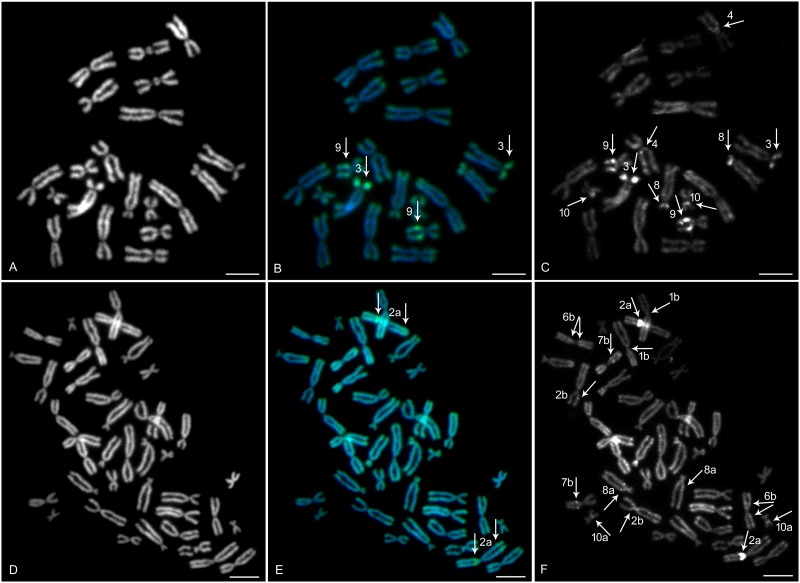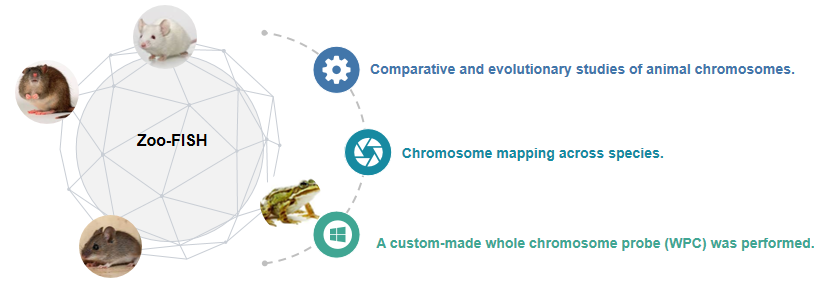Animal Comparative Cytogenetics and ZOO-FISH
Creative Bioarray provides an in situ visualization solution for whole-chromosome mapping-based comparative cytogenetic studies in animals. Our technology platform offers a variety of probe customization options to help researchers explore questions about species evolution and comparative cytogenetics. Our services can realize technical services such as chromosome microdissection and BCA probe customization. Diversified choices, high-quality service teams, and complete equipment platforms give us the confidence to provide customers with comprehensive research services with rapid turnaround.
Animal Comparative Cytogenetics
The introduction of molecular cytogenetic methods has facilitated comparative mapping between species with highly rearranged karyotypes and distantly related species, replacing earlier methods of comparing the karyotypes of closely related species by chromosome banding. This information is a prerequisite for understanding karyotype phylogeny and reconstructing common ancestral karyotypes. Zoo-FISH (cross-species fluorescence in situ hybridization), also known as cross-species chromosome painting or comparative chromosome painting, essentially describes the use of the whole chromosome- or chromosomal arm- or region-specific painting probes to delimit homologous segments (chromosome or chromosomal segments with evolutionarily conserved synteny) in other species by means of FISH. The introduction of chromosome mapping techniques into the field of primate comparative cytogenetics offers the possibility to compare distantly related species (eg, from different target species). Genome-wide comparative chromosomal maps have been reported between humans and nearly all 18 extant representative eutherian species. At the same time, the invention of DOP-PCR, coupled with chromosome sorting by flow cytometry, made it possible to generate mapping probes for any given vertebrate species and to perform multidirectional cross-species chromosome mapping.
 Fig 1. Sequential fluorescent chromosome banding on metaphase spread of X. tropicalis and X. mellotropicalis. (Martin et al., 2017)
Fig 1. Sequential fluorescent chromosome banding on metaphase spread of X. tropicalis and X. mellotropicalis. (Martin et al., 2017)
Zoo-FISH and Comparative Genome Analysis
Zoo-FISH technology facilitates cross-species chromosome mapping, animal chromosome comparison, and evolutionary studies. This technology is performed with custom-made whole-chromosome probes (WPCs), and site-specific probe sets can also be customized according to research needs. Current probe generation methods include flow sorting or microdissection. Identical chromosomes were isolated from metaphase spreads and then nonspecifically amplified using degenerate primers and labeled with fluorophore-conjugated or haptenated nucleotides to prepare appropriate probes. Our technology platform provides a variety of probe customization services, including BCA probe customization, fiber cleavage, and probe customization, and DOP-PCR probe customization services.
 Fig 2. ZOO-FISH for animal comparative cytogenetics.
Fig 2. ZOO-FISH for animal comparative cytogenetics.
Technology Features
Compared with the intraspecific chromosome staining protocol, the Zoo-FISH protocol has been adjusted in the following links.
- Increase the probe concentration
- Increase the time of hybridization
- Improves accessibility of target chromosomal DNA by enzymatic digestion of unwanted cytoplasmic background overlays, debris and chromosomal proteins
If you are interested in our service, please contact us for cooperation. We look forward to cooperating with you in the near future.
References
- Knytl, Martin, et al. "Chromosome divergence during evolution of the tetraploid clawed frogs, Xenopus mellotropicalis and Xenopus epitropicalis as revealed by Zoo-FISH." PLoS One 12.5 (2017): e0177087.
- García-Angulo, Aglaya, et al. "Evidence for a Robertsonian fusion in Solea senegalensis (Kaup, 1858) revealed by zoo-FISH and comparative genome analysis." BMC genomics 19.1 (2018): 1-11.
All products and services on this website are only suitable for non-medical purposes.


 Fig 1. Sequential fluorescent chromosome banding on metaphase spread of X. tropicalis and X. mellotropicalis. (Martin et al., 2017)
Fig 1. Sequential fluorescent chromosome banding on metaphase spread of X. tropicalis and X. mellotropicalis. (Martin et al., 2017) Fig 2. ZOO-FISH for animal comparative cytogenetics.
Fig 2. ZOO-FISH for animal comparative cytogenetics.


